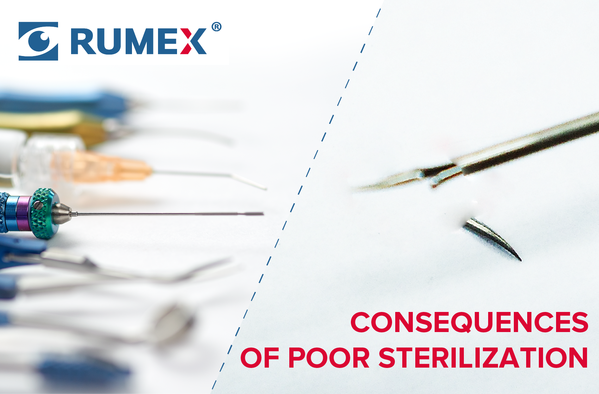
The dangers of sterilization
You may believe that sterilization affects primarily medical aspects of ophthalmic instrument usage. It is a fact, insufficient sterilization may lead to complicated or even tragic outcomes, but from instrument manufacturer’s point of view, it is just a part of the story. Being «quality maniacs», we at RUMEX collect usage and claims statistics from all over the world and we can definitely point out several more aspects of sterilization.
Briefly, in case of instruments manufactured by RUMEX handling and sterilization mistakes are the main reason for premature failure and substitution of microsurgical instruments, far beyond their natural deterioration under normal usage conditions or workmanship defects. In addition, as opposed to the latter covered by our lifetime warranty, wrong sterilization is not a subject to our warranty.
Firstly, instruments are damaged mechanically while handling: they are being dropped, bent, scratched, etc. Our tiny ophthalmic instruments are by definition more fragile than most surgical instruments, hence ordinary (for big surgical instruments) handling practices means barbarian destruction for ophthalmic instruments.
Secondly, no matter how good the stainless steel is (and we use probably the best steel in this world) nurses and technicians can find such tough conditions far beyond permitted by sterilization instruction when even the best stainless steel begins to rust. Fortunately, most of our instruments are made of titanium; hence, they are almost free from this feature, although the most creative cleaners can find such an aggressive chemical agent and such a heating temperature that even coated titanium will surrender, albeit at incomparably harsher conditions than needed for stainless steel to corrode.
Thirdly, residual biological contaminations are not only potentially disastrous for patients; they can also stay on the surface or more often inside an instrument after its careless sterilization, often causing malfunction or even total destruction of its fragile mechanism, in the worst case scenario deep in a patient’s eye. This problem is more typical for instruments with very small moving details such as vitreoretinal or other micro-incisional instruments.
No matter how good materials we use, how well we develop and manufacture instruments, how we torture test them, only correct handling sterilization is the key to their long life no to say about patient health.
Briefly, in case of instruments manufactured by RUMEX handling and sterilization mistakes are the main reason for premature failure and substitution of microsurgical instruments, far beyond their natural deterioration under normal usage conditions or workmanship defects. In addition, as opposed to the latter covered by our lifetime warranty, wrong sterilization is not a subject to our warranty.
Firstly, instruments are damaged mechanically while handling: they are being dropped, bent, scratched, etc. Our tiny ophthalmic instruments are by definition more fragile than most surgical instruments, hence ordinary (for big surgical instruments) handling practices means barbarian destruction for ophthalmic instruments.
Secondly, no matter how good the stainless steel is (and we use probably the best steel in this world) nurses and technicians can find such tough conditions far beyond permitted by sterilization instruction when even the best stainless steel begins to rust. Fortunately, most of our instruments are made of titanium; hence, they are almost free from this feature, although the most creative cleaners can find such an aggressive chemical agent and such a heating temperature that even coated titanium will surrender, albeit at incomparably harsher conditions than needed for stainless steel to corrode.
Thirdly, residual biological contaminations are not only potentially disastrous for patients; they can also stay on the surface or more often inside an instrument after its careless sterilization, often causing malfunction or even total destruction of its fragile mechanism, in the worst case scenario deep in a patient’s eye. This problem is more typical for instruments with very small moving details such as vitreoretinal or other micro-incisional instruments.
No matter how good materials we use, how well we develop and manufacture instruments, how we torture test them, only correct handling sterilization is the key to their long life no to say about patient health.
